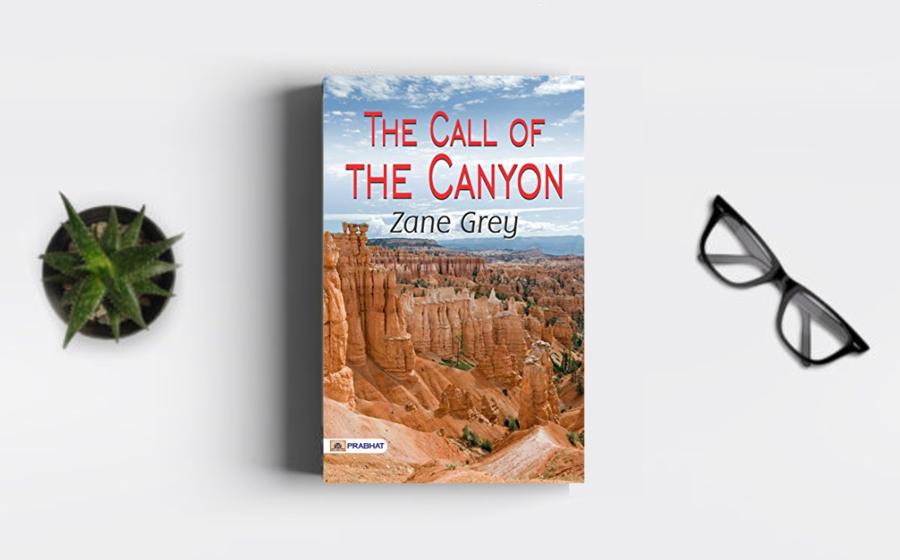"The Call of the Canyon" by Zane Grey, published in
1924, stands as a poignant exploration of love, loss,
and the pursuit of the American Dream. Rooted in the
post-World War I era, this classic novel weaves a
narrative that resonates with universal themes and
captures the spirit of a transformative period in
American history. Zane Grey's evocative storytelling,
vivid characters, and exploration of the complexities of
human relationships elevate "The Call of the Canyon" to
its status as one of the top American classics of all
time.
Set against the backdrop of the Roaring
Twenties, the novel introduces readers to the
protagonist, Glenn Kilbourne, a disillusioned and
war-weary veteran who returns to his home in New York
City after the war. Struggling with the emptiness and
materialism of post-war society, Glenn receives a letter
that changes the course of his life. The letter, from
his cousin Carley Burch, invites him to visit her in the
enchanting landscape of Oak Creek Canyon in Arizona.
One of the defining strengths of "The Call of the
Canyon" is its vivid portrayal of the American West,
particularly the picturesque and awe-inspiring setting
of Oak Creek Canyon. Zane Grey's descriptive prose
brings the Arizona landscape to life, allowing readers
to immerse themselves in the beauty and majesty of the
canyon. The natural surroundings become an integral part
of the narrative, serving as both a backdrop and a
metaphor for the characters' journeys of self-discovery
and renewal.
At its core, the novel is a love
story, exploring the complexities of romantic
relationships and the impact of war on the human psyche.
Glenn Kilbourne's journey to Oak Creek Canyon becomes a
quest for emotional healing and renewal. The character
of Carley Burch, with her vivacity and free-spirited
nature, embodies the transformative power of love and
the potential for personal growth. The evolving dynamic
between Glenn and Carley forms the emotional core of the
narrative, resonating with readers through its
exploration of hope, sacrifice, and the resilience of
the human spirit.
The thematic exploration of the
American Dream is another notable aspect that
contributes to the novel's enduring relevance. The
post-war period marked a time of societal upheaval, as
individuals grappled with the aftermath of global
conflict and sought new meaning in their lives. "The
Call of the Canyon" reflects this societal shift,
examining the pursuit of happiness, success, and
fulfillment in the context of changing values and
priorities. The characters' quests for a meaningful life
mirror the broader cultural shifts of the era.
Grey's characters are richly developed, each possessing
unique qualities and facing internal conflicts that add
depth to the narrative. Glenn Kilbourne's internal
struggles, Carley Burch's journey of self-discovery, and
the supporting cast of characters collectively form a
tapestry of human experiences. The characters'
interactions and relationships serve as a reflection of
the societal changes occurring during the post-war
period, allowing readers to connect with the story on
both personal and cultural levels.
The
exploration of psychological trauma and the impact of
war on individuals sets "The Call of the Canyon" apart
as a nuanced and introspective work. Glenn Kilbourne's
experiences in the war profoundly shape his worldview
and contribute to his sense of disillusionment upon
returning home. The novel delves into the psychological
scars left by war, portraying the challenges of
readjustment and the quest for meaning in a world
forever changed by conflict. Grey's sensitive handling
of these themes adds a layer of emotional depth to the
narrative.
The novel's enduring popularity is
further enhanced by its cinematic adaptation. In 1923, a
silent film adaptation of "The Call of the Canyon" was
released, bringing Grey's story to a wider audience.
While the film took liberties with the source material,
it contributed to the novel's cultural impact and
introduced the narrative to new generations of readers
and viewers.
Zane Grey's prose style is
characterized by its accessibility and emotional
resonance. The author's straightforward yet evocative
writing allows readers to connect with the characters
and their experiences on an intimate level. Grey's
ability to capture the nuances of human emotions,
coupled with his descriptive prowess, ensures that "The
Call of the Canyon" remains a compelling and engaging
read.
"The Call of the Canyon" by Zane Grey stands as a timeless American classic that explores the complexities of love, loss, and the pursuit of the American Dream in the aftermath of World War I. The novel's vivid depiction of the Arizona landscape, its richly developed characters, and its exploration of universal themes contribute to its status as one of the top American classics of all time.






